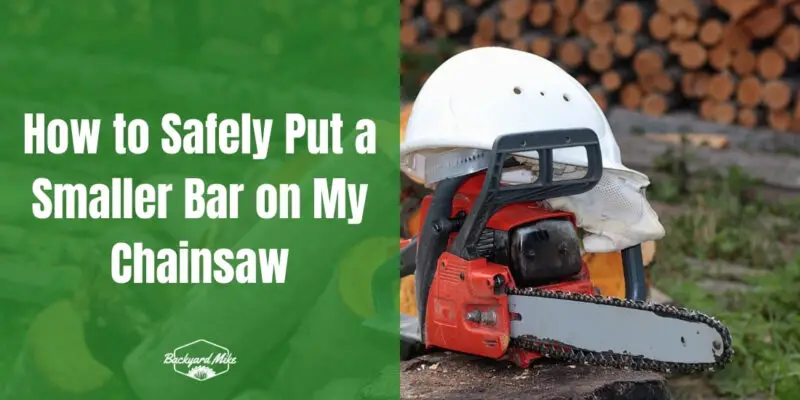To safely put a smaller bar on your chainsaw, start by checking compatibility with your chainsaw's power, chain pitch, and gauge. Gather your safety gear and tools. On a stable surface, remove the side cover and loosen the chain tension. Unfasten the bar nuts and withdraw the old bar. Check the new bar matches your chainsaw's specifications, then attach and adjust the chain tension. Tighten everything securely. Continue to guarantee regular maintenance for peak performance and safety.
Key Takeaways
- Verify new bar compatibility with chainsaw model, including pitch, gauge, and mount specifications.
- Gather safety gear and tools before starting the installation process.
- Remove protective side covers and loosen chain tension to access the bar.
- Replace the old bar with the new one, ensuring a secure fit and proper chain tension.
- Regularly inspect and maintain your chainsaw for safety and performance.
Understanding the Benefits of a Smaller Chainsaw Bar
When considering the benefits of a smaller chainsaw bar, it's essential to understand how this choice can greatly enhance safety and operational efficiency. By opting for a shorter bar, you reduce the risk of kickback due to less chain exposure at the tip, which is a significant safety advantage. This choice also improves your control over the saw, making it easier to maneuver, especially in tight spaces. With a smaller bar, the chainsaw becomes lighter, reducing fatigue and helping you work longer with less strain. Lightweight bars are less stiff than conventional bars, which may affect rigidity but still provide balance improvements. Regarding operational efficiency, a shorter bar allows the motor to utilize power more effectively, leading to faster, more precise cuts. Additionally, you'll find reduced lubrication needs and simpler chain adjustments, saving time and money. Investing in a chainsaw with safety features like an anti-kickback chain and anti-vibration system further enhances safety and operational control.
Ensuring Compatibility With Your Chainsaw
Choosing a smaller chainsaw bar offers many advantages, but guaranteeing compatibility with your chainsaw is just as important.
Start by checking the bar specifications. The bar length should match your chainsaw's power to avoid straining the engine. Verify the chain pitch and gauge align with the bar to prevent binding and excessive friction. Ensuring that the chainsaw bars match in length, pitch, and gauge is crucial for optimal performance and safety. It's important to consider the type of chainsaw bar when selecting a new bar, as the right type can significantly impact performance and handling.
Make sure the bar mount fits your chainsaw's configuration for safe operation. Count the drive links on your chain to guarantee they suit the new bar size, maintaining chainsaw performance.
Consult your chainsaw manual for specific model requirements and safety considerations. By matching the bar specifications with your chainsaw's capabilities, you'll optimize performance and safety, ensuring the tool functions effectively for your cutting tasks.
Preparing Tools and Materials
To prepare your tools and materials effectively, begin by gathering essential safety equipment, including gloves, safety glasses, and ear protection, to guarantee your personal safety during the process. Tool organization is essential, so arrange everything neatly to assure a smooth workflow. Have a stable surface to work on, like a piece of lumber or a holding device, to lay your chainsaw securely. Compact chainsaws often feature shorter cutting lengths, which makes them more manageable for smaller jobs. Measure the bar and chain with a ruler or measuring tape, confirming the new parts fit your saw. Understanding the types of chainsaws is crucial when selecting a smaller bar, as different chainsaw models have specific compatibility requirements. Keep your instructions manual handy, as it provides specifications for compatible bar sizes. Finally, a chainsaw chain breaker is important for adjusting or shortening the chain if needed.
Gather essential safety gear like gloves, glasses, and ear protection to ensure safety during your task.
- Safety Equipment: Gloves, glasses, ear protection
- Measuring Tools: Ruler, tape
- Stable Platform: Lumber, holding device
- Instructions Manual: Specifications guide
- Chainsaw Chain Breaker: Chain adjustment tool
Step-by-Step Installation Process
With your tools and materials prepared, you're ready to start the step-by-step installation process.
First, remove the protective side covers to access the bar and chain assembly. Loosen the chain tension by turning the screw counterclockwise. Use a scrench to unfasten the bar holder nuts, then gently withdraw the old bar. Clear any debris from the sprocket area, following safety precautions. Flipping the bar can extend its life by utilizing both sides, and visual inspections may reveal uneven wear.
Next, verify the new bar gauge matches the chainsaw's hardware and check chain length requirements. Slide the new bar onto its studs, wrapping the chain around it. Guide the chain over the sprocket, aligning the bar precisely.
Securely tighten all nuts and screws, adjusting the chain tension as needed. These installation tips guarantee your chainsaw's safe and efficient operation.
Maintaining Your Chainsaw for Optimal Performance
Maintaining your chainsaw for peak performance requires regular care and attention. Start by focusing on chain sharpening—keeping it sharp is vital for efficient cutting and minimizing kickback risks. Don't forget about bar lubrication; it's important for reducing wear on moving parts and boosting overall performance. Daily cleaning before and after use will keep your chainsaw in top shape, guaranteeing it's ready for the next task. Regular inspections for worn parts, like the bar and chain, help prevent potential hazards. Before and after every use, conduct a visual check for damage on the chainsaw and controls to ensure optimal cutting performance and longevity. Remember to check the chain tension frequently, as proper tension guarantees straight cuts and prevents accidents.
- Daily Cleaning: Maintain performance and longevity.
- Chain Tension: Guarantee straight cuts, prevent accidents.
- Chain Sharpening: Efficient cutting, reduce kickback.
- Bar Lubrication: Minimize wear, improve performance.
- Regular Inspections: Identify potential hazards.
Frequently Asked Questions
Can a Smaller Bar Handle Hardwood Cutting Efficiently?
You'll find that a smaller bar improves cutting efficiency in tight spaces and smaller logs. However, bar compatibility with your chainsaw and engine power is essential, especially with hardwood. Make sure everything's aligned for safe, efficient cutting.
What Are the Signs of Improper Chain Tension?
You notice improper chain tension when your saw stalls, jerks, or cuts poorly. Common mistakes include too tight or loose chains, leading to kickback or derailment. Regular checks can build confidence and foster a safe, inclusive environment.
How Do I Identify a Quality Replacement Bar?
To identify a quality replacement bar, look for high-grade bar material and a suitable bar length that matches your chainsaw's specifications. Choose a bar that enhances performance and safety, ensuring you feel confident and part of the community.
Are There Specific Brands Recommended for Durability?
You're wondering about durable bar brands, right? Comparing options like GB, Oregon, Husqvarna, Tsumara, and Sugihara can guide you. Each brand is renowned for quality, ensuring you're part of a community that values long-lasting performance.
Can I Use the Same Chain for Different Bar Lengths?
You'd think one chain fits all, right? But no, chain compatibility depends on bar length. Verify the pitch and gauge match, or your dream of effortless sawing becomes a risky reality. Stay informed, stay safe.
Conclusion
To safely install a smaller bar on your chainsaw, guarantee each step is followed with precision. Confirm compatibility to avoid mishaps, gather necessary tools, and proceed with the installation methodically. Like a well-tuned instrument, your chainsaw will hum smoothly when maintained properly. Regular check-ups and cleaning will prolong its life and enhance performance. Remember, a chainsaw is a powerful tool—handle it with respect and care to harvest the benefits of your labor safely.


